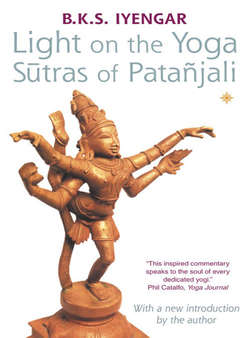Читать книгу Light on the Yoga Sutras of Patanjali - Литагент HarperCollins USD - Страница 10
Samadhi Pada
ОглавлениеThe first chapter, samadhi pada, defines yoga and the movement of the consciousness, citta vrtti. It is directed towards those who are already highly evolved to enable them to maintain their advanced state of cultured, matured intelligence and wisdom. Rare indeed are such human souls who experience samadhi early in life, for samadhi is the last stage of the eightfold path of yoga. Samadhi is seeing the soul face to face, an absolute, indivisible state of existence, in which all differences between body, mind and soul are dissolved. Such sages as Hanuman, suka, Dhruva, Prahlada, sankaracarya, Jñanesvar, Kabir, Svami Ramdas of Maharastra, Ramakrsna Paramahamsa and Ramata Maharsi, evolved straight to Kaivalya without experiencing the intermediate stages of life or the various stages of yoga. All the actions of these great seers arose from their souls, and they dwelled throughout their lives in a state of unalloyed bliss and purity.
The word samadhi is made up of two components. Sama means level, alike, straight, upright, impartial, just, good and virtuous; and adhi means over and above, i.e. the indestructible seer. Samadhi is the tracing of the source of consciousness – the seer – and then diffusing its essence, impartially and evenly, throughout every particle of the intelligence, mind, senses and body.
We may suppose that Patañjali’s intention, in beginning with an exegesis of samadhi, was to attract those rare souls who were already on the brink of Self-Realization, and to guide them into experiencing the state of nonduality itself. For the uninitiated majority, the enticing prospect of samadhi, revealed so early in his work, serves as a lamp to draw us into yogic discipline, which will refine us to the point where our own soul becomes manifest.
Patañjali describes the fluctuations, modifications and modulations of thought which disturb the consciousness, and then sets out the various disciplines by which they may be stilled. This has resulted in yoga being called a mental sadhana (practice). Such a sadhana is possible only if the accumulated fruits derived from the good actions of past lives (samskaras) are of a noble order. Our samskaras are the fund of our past perceptions, instincts and subliminal or hidden impressions. If they are good, they act as stimuli to maintain the high degree of sensitivity necessary to pursue the spiritual path.
Consciousness is imbued with the three qualities (gunas) of luminosity (sattva), vibrancy (rajas) and inertia (tamas). The gunas also colour our actions: white (sattva), grey (rajas) and black (tamas). Through the discipline of yoga, both actions and intelligence go beyond these qualities and the seer comes to experience his own soul with crystal clarity, free from the relative attributes of nature and actions. This state of purity is samadhi. Yoga is thus both the means and the goal. Yoga is samadhi and samadhi is yoga.
There are two main types of samadhi. Sabija or samprajñata samadhi is attained by deliberate effort, using for concentration an object or idea as a ‘seed’. Nirbija samadhi is without seed or support.
Patañjali explains that before samadhi is experienced the functioning of consciousness depends upon five factors: correct perception, misperception (where the senses mislead), misconception or ambiguousness (where the mind lets one down), sleep, and memory. The soul is pure, but through the sullying or misalignment of consciousness it gets caught up in the spokes of joys and sorrows and becomes part of suffering, like a spider ensnared in its own web. These joys and sorrows may be painful or painless, cognizable or incognizable.
Freedom, that is to say direct experience of samadhi, can be attained only by disciplined conduct and renunciation of sensual desires and appetites. This is brought about through adherence to the ‘twin pillars’ of yoga, abhyasa and vairagya.
Abhyasa (practice) is the art of learning that which has to be learned through the cultivation of disciplined action. This involves long, zealous, calm, and persevering effort. Vairagya (detachment or renunciation) is the art of avoiding that which should be avoided. Both require a positive and virtuous approach.
Practice is a generative force of transformation or progress in yoga, but if undertaken alone it produces an unbridled energy which is thrown outwards to the material world as if by centrifugal force. Renunciation acts to shear off this energetic outburst, protecting the practitioner from entanglement with sense objects and redirecting the energies centripetally towards the core of being.
Patañjali teaches the sadhaka to cultivate friendliness and compassion, to delight in the happiness of others and to remain indifferent to vice and virtue so that he may maintain his poise and tranquillity. He advises the sadhaka to follow the ethical disciplines of yama and niyama, the ten precepts similar to the Ten Commandments, which govern behaviour and practice and form the foundation of spiritual evolution. He then offers several methods through which consciousness detaches itself from intellectual and emotional upheavals and assumes the form of the soul – universal, devoid of all personal and material identity. The sadhaka is now filled with serenity, insight and truth. The soul, which until now remained unmanifest, becomes visible to the seeker. The seeker becomes the seer: he enters a state without seed or support, nirbija samadhi.
